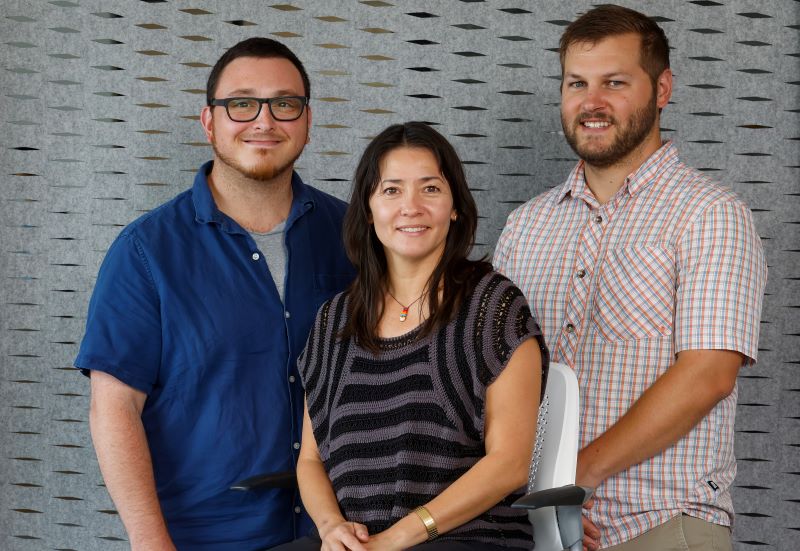Kotche, Felder, and Browne enhance program to better BME student innovative development
text Heading link

A previous experience involving the UIC College of Medicine’s Department of Ophthalmology and Visual Sciences in 2019 propelled the advancement of the Clinical Immersion Program (CIP), a program designed to enhance innovative project development and student performance for Richard and Loan Hill Department of Biomedical Engineering students.
The CIP was first created in 2014 to give biomedical engineering students an opportunity to identify new clinical needs and was later expanded in 2016 to include Innovation in Medicine (IMed) students. In 2019, ophthalmology students identified a need related to the collection of tear film, a thin protective fluid that covers the ocular surface. In turn, Richard and Loan Hill Clinical Professor Miiri Kotche and Clinical Associate Professor Anthony Felder then transitioned the project to senior design students in the College of Engineering who created a functional device to collect this film. This work demonstrated just how much these projects could evolve and further student development, piloting the pipeline they are currently researching.
At the time, Felder co-directed the clinical immersion program with Kotche with an R25 grant from the National Institute of Biomedical Imaging and Bioengineering (NIBIB) of the NIH. Taking inspiration from the ophthalmology project in 2019, Felder, Kotche, and Clinical Assistant Professor Michael Browne were recently awarded a new R25 to codify the longitudinal development of projects identified from the clinical immersion program.
This new research is an enhancement of their previous work and connects the undergraduate curriculum to the clinical immersion program.
The grant aims to create a distributed and interdisciplinary pipeline for sustainable student-driven innovation. Browne, Felder, and Kotche are enhancing the education of biomedical engineering students by focusing on the real-world experiences of developing prototypes that go from clinical identification through advanced development across many disciplines.
The pipeline consists of new and revised courses and programs to identify clinical needs and develop compelling solutions to meet them. Included within the pipeline is a new physical prototyping course to develop and practice essential fabrication skills, a revised CIP to serve as a project source, an updated BME senior design course to accept projects from CIP while fostering interdisciplinary collaboration, and a process for including medical students.
The new prototyping class was piloted in the fall of 2022. It is designed to provide biomedical engineering students with the essential skills to empower them through their educational journey and senior design course.
One of their goals is to define a means for longitudinal development of students’ projects and abilities. Longitudinal development refers to the transition of a project through this pipeline. In this manner, the development stretches into more technical accomplishment over time.
They hope to ideally recruit sophomores and juniors for the prototyping class so they can strengthen their confidence and better their skills prior to senior design. Browne and Felder advise the senior design course within the biomedical engineering department, which is required for all engineering students.
During senior design, “we found that a lot of times their ability to make things is deficient,” Felder said. “With this pipeline, we hope to maintain project continuity across a variety of student experiences and use that momentum to ultimately enhance their engineering competency and preparedness.”
Felder added they spend a lot of time supporting technical development for students in senior design, along with making sure they develop the right product.
“Students are really eager to get their hands on things and build things, but they lean on techniques that they’ve learned elsewhere in the curriculum,” Browne said. “When it comes to developing prototypes, we want them to explore past those previous techniques, so we want to add to their toolbox of skills so that they have more skills and more technological options to use.”
For example, when students learn about 3D printing suddenly every project requires 3D printing, and the truth is that most things don’t so we’re trying to break bad habits, Felder said.
The pipeline represents a new opportunity for students to experience more advanced project development. Today, about 70% of UIC BME students earn a bachelor’s degree and immediately take a job in industry. Fifteen to twenty years ago, Felder noted, this was uncommon, as there were very few jobs and most curriculums trained students to go to graduate school, so this pipeline also represents a shift in the curriculum, attempting to better prepare BME students for industry.
These changes include a curriculum that is tied closer to reality to help students to find positions faster, be more prepared throughout their careers, and have better experiences to leverage in their interviews and ways to represent themselves as a practicing engineer.
“In engineering education, we’re so focused on the technical components of the curriculum and being an engineer and industry relies heavily on that, but clinical immersion really gives students unique skills that other disciplines don’t so they get this experience put into this practice of biomedical engineering,” Browne said. “That’s a really unique and rare experience that is really exciting that we have students who can then leverage that for their careers it gives them a certain kind of empathy but allow them to see things from a better perspective of their colleagues, physicians and nurses, and patients.”